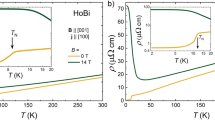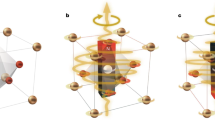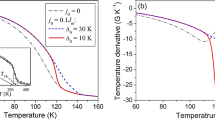Abstract
THE dielectric properties of Rochelle salt, potassium dihydrogen phosphate and potassium dihydrogen arsenate, depend on the electric field in the same way that the properties of ferromagnetic substances depend on the magnetic field. The spontaneous polarization is large between the two Curie points and depends on temperature. Approaching the higher (normal) Curie point from lower temperatures, the spontaneous polarization vanishes. As a consequence the specific heat shows an anomaly, corresponding to the magneto-caloric effect in ferromagnetics.
This is a preview of subscription content, access via your institution
Access options
Subscribe to this journal
Receive 51 print issues and online access
$199.00 per year
only $3.90 per issue
Buy this article
- Purchase on SpringerLink
- Instant access to full article PDF
Prices may be subject to local taxes which are calculated during checkout
Similar content being viewed by others
References
Kobeko and Nelidow, Phys. Z. d. Sowjetunion, 1, 382 (1932).
Rusterholz, Helv. phys. Acta, 8, 39 (1934).
Wilson, Phys. Rev., 54, 1103 (1938).
Hicks and Hooley, J. Amer. Chem. Soc., 60, 2994 (1938).
Hablützel, Helv. phys. Acta, in the Press.
Busch, Helv. phys. Acta, 11, 269 (1938).
Author information
Authors and Affiliations
Rights and permissions
About this article
Cite this article
BANTLE, W., SCHERRER, P. Anomaly of the Specific Heat of Potassium Dihydrogen Phosphate at the Upper Curie Point. Nature 143, 980 (1939). https://doi.org/10.1038/143980a0
Issue date:
DOI: https://doi.org/10.1038/143980a0



